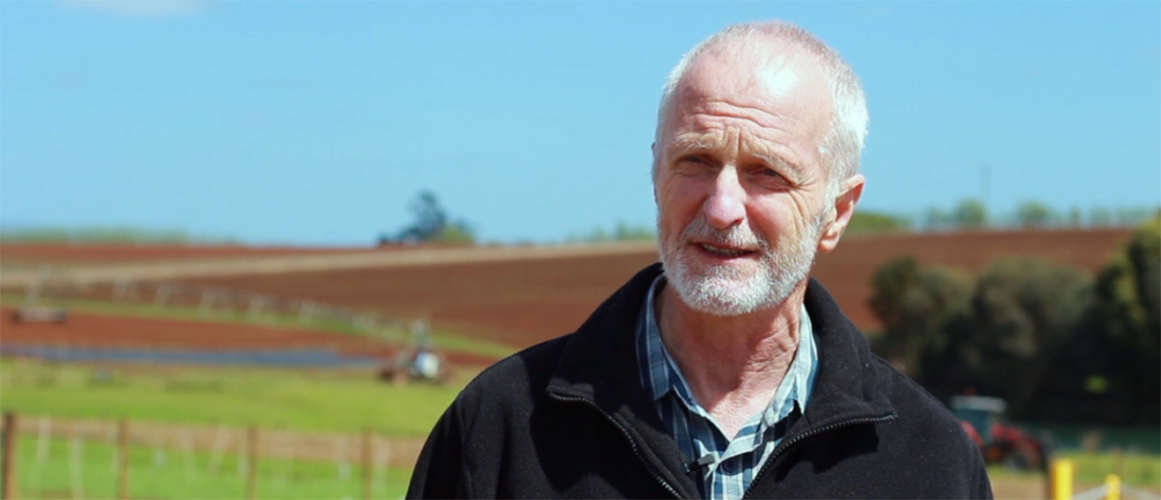
Tasmanian Institute of Agriculture researchers investigate soil health for potato production
17 December 2018
John Cresswell: Minimising disease risk for a sustainable future
19 December 2018Research into optimising cover cropping for the Australian vegetable industry is aiming to combine new science, machinery and management practices that growers, such as Premium Fresh Tasmania Farm Manager Deon Gibson, can use to improve their yields and ultimately increase prices.
Fast facts
Name: Deon Gibson
Location: Forth, Tasmania
Works: Premium Fresh Tasmania
Grows: Carrots
Award-winning carrots are just one sign for Deon Gibson that patience has its own rewards when using cover cropping.
Inspired by 2015 Farmer of the Year Grant Sims, local Tasmanian grower Darren Long and various field days and walks, the Premium Fresh Tasmania Farm Manager started to revive cover cropping on his property. Deon is now working with others from Queensland and Victoria on a three-year project with Applied Horticultural Research scientist Dr Kelvin Montagu entitled Optimising cover cropping for the Australian vegetable industry (VG16068), a strategic levy investment under the Hort Innovation Vegetable Fund.
For this project, Deon has set up his 300-hectare farm at Forth on a four- or five-year paddock rotation, giving selected paddocks a 12-18 month rest with selected cover crops. The emphasis on quality over quantity has suppressed weeds, improved operational efficiencies and protected the soil rather than leaving the paddocks exposed to the elements.
“It has been a revelation for us. We’ve never had such healthy-looking carrots. There are no nematodes, the crops have beautiful green, healthy tops and they’re in free-draining soil. And in terms of cultivation, the soil breaks down very easily and has plenty of organic material and worms and dung beetles,” Deon says.
“Your soil is a living organism and you don’t want it to die, so you want something growing in there – even if it’s only a shortterm cover crop, you’re protecting that soil.
“Doing so over summer means you’re not getting all the extremes with a 30-degree sun hitting the bare soil and doing lots of damage to the surface. The same applies in winter. That’s where cover cropping maintains the consistency.”
"It's my hope to follow through and produce long-term results that will benefit all. Everyone's back pocket will be helped. At the end of it, I'm sure I'll be really proud of this."
Patience pays off
Deon says sticking with covered cropping beyond “trying one year and not the next” was netting excellent results in terms of better yields and premium prices.
“You still have to grow the cover crop – not just put it in and forget about it. I’ve found to get the best out of it, you give it that little bit more and you get twice the result. It’s really about keeping your cool and not using your soil when it’s not fit to be used,” he says.
“Because of financial imperatives there’s often too much of a push on the soil but, where possible, I’d rather be rejuvenating the soil than just have a marginal crop on it.
“I’ve seen that one bad decision can undo a paddock for four or five years where a harvest has depleted and destroyed the soil structure. Yet after cover cropping, our horsepower, fuel and irrigation requirements are reduced, and our soil isn’t as tight and bashed down as we’re not trying to turn it to plant a crop in the next day.
“Likewise, with strip plots all the natural drain and nutrients are still there because you haven’t smashed it up. We’re back on it in no time, and there’s no erosion because the water filters down from the harder bits where you’ve worked before.”

Long-term goals
Deon says the scientific tools available are improving, such as penetrometer readings, and greater analysis by agronomists is deepening the physiological understanding of cover crops.
The project’s end goal is to create a range of templates, such as booklets or guides, that highlight the estimated costs of what to grow, which cover crops and practices work best with different crops, and the expected results.
“It’s my hope to follow through and produce long-term results that will benefit all. Everyone’s back pocket will be helped. At the end of it, I’m sure I’ll be really proud of this.”
Optimising cover cropping for the Australian vegetable industry has been funded by Hort Innovation using the vegetable research and development levy and contributions from the Australian Government.
This grower profile first appeared in Grower Success Stories, a levy-funded booklet published by AUSVEG to promote real results from levy investment, and was featured in the AUSVEG Weekly Update published 8 January 2019. If you’d like to subscribe to receive AUSVEG publications, use our online subscription form!
Photography credit: Flick + Dave Photography

